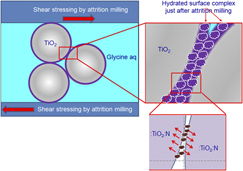Crossref Citations
This article has been cited by the following publications. This list is generated based on data provided by
Crossref.
Baláž, Peter
Achimovičová, Marcela
Baláž, Matej
Billik, Peter
Cherkezova-Zheleva, Zara
Criado, José Manuel
Delogu, Francesco
Dutková, Erika
Gaffet, Eric
Gotor, Francisco José
Kumar, Rakesh
Mitov, Ivan
Rojac, Tadej
Senna, Mamoru
Streletskii, Andrey
and
Wieczorek-Ciurowa, Krystyna
2013.
Hallmarks of mechanochemistry: from nanoparticles to technology.
Chemical Society Reviews,
Vol. 42,
Issue. 18,
p.
7571.
Senna, Mamoru
2013.
Intriguing Phenomena at the Boundary between Metal Oxide - Organic Fine Particles and their Industrial Application.
Journal of the Society of Powder Technology, Japan,
Vol. 50,
Issue. 6,
p.
436.
Senna, Mamoru
2014.
Toward Better Transfer from Materials Research to Affordable Production Processes.
Journal of the Society of Powder Technology, Japan,
Vol. 51,
Issue. 9,
p.
653.
Senna, M.
2014.
Foundation and application of solid-state processes at inorganic–organic particulate boundaries.
Advanced Powder Technology,
Vol. 25,
Issue. 1,
p.
114.
Karim, Mohammad Rezaul
Bhuiyan, Mohammad Tauhidul Islam
Dar, Mushtaq Ahmad
Seikh, Asiful Hossain
Ali Shar, Muhammad
Zaman, Mohammed Badruz
Lee, Chul Jae
Kim, Hee Jin
and
Lee, Mu Sang
2015.
Synthesis and characterization of highly organized crystalline rutile nanoparticles by low-temperature dissolution-reprecipitation process.
Journal of Materials Research,
Vol. 30,
Issue. 12,
p.
1887.
Li, Youji
Li, Ming
Xu, Peng
Tang, Shaohua
and
Liu, Chen
2016.
Efficient photocatalytic degradation of acid orange 7 over N-doped ordered mesoporous titania on carbon fibers under visible-light irradiation based on three synergistic effects.
Applied Catalysis A: General,
Vol. 524,
Issue. ,
p.
163.
Albetran, Hani
and
Low, It Meng
2016.
Effect of indium ion implantation on crystallization kinetics and phase transformation of anodized titania nanotubes using in-situ high-temperature radiation diffraction.
Journal of Materials Research,
Vol. 31,
Issue. 11,
p.
1588.
von Moos, Nadia
Koman, Volodymyr B.
Santschi, Christian
Martin, Olivier J. F.
Maurizi, Lionel
Jayaprakash, Amarnath
Bowen, Paul
and
Slaveykova, Vera I.
2016.
Pro-oxidant effects of nano-TiO2on Chlamydomonas reinhardtii during short-term exposure.
RSC Advances,
Vol. 6,
Issue. 116,
p.
115271.
Milosevic, Irena
Jayaprakash, Amarnath
Greenwood, Brigitte
Van Driel, Birgit
Rtimi, Sami
and
Bowen, Paul
2017.
Synergistic Effect of Fluorinated and N Doped TiO2 Nanoparticles Leading to Different Microstructure and Enhanced Photocatalytic Bacterial Inactivation.
Nanomaterials,
Vol. 7,
Issue. 11,
p.
391.
Bujňáková, Zdenka
Dutková, Erika
Zorkovská, Anna
Baláž, Matej
Kováč, Jaroslav
Kello, Martin
Mojžiš, Ján
Briančin, Jaroslav
and
Baláž, Peter
2017.
Mechanochemical synthesis and in vitro studies of chitosan-coated InAs/ZnS mixed nanocrystals.
Journal of Materials Science,
Vol. 52,
Issue. 2,
p.
721.
Takai, Chika
Senna, Mamoru
Hoshino, Satoshi
Razavi-Khosroshahi, Hadi
and
Fuji, Masayoshi
2018.
Chemical and thermal properties of VO2 mechanochemically derived from V2O5 by co-milling with paraffin wax.
RSC Advances,
Vol. 8,
Issue. 38,
p.
21306.
Milošević, I.
Rtimi, S.
Jayaprakash, A.
van Driel, B.
Greenwood, B.
Aimable, A.
Senna, M.
and
Bowen, P.
2018.
Synthesis and characterization of fluorinated anatase nanoparticles and subsequent N-doping for efficient visible light activated photocatalysis.
Colloids and Surfaces B: Biointerfaces,
Vol. 171,
Issue. ,
p.
445.
Chakraborty, Amlan
Boer, Jennifer C.
Selomulya, Cordelia
and
Plebanski, Magdalena
2018.
Amino Acid Functionalized Inorganic Nanoparticles as Cutting-Edge Therapeutic and Diagnostic Agents.
Bioconjugate Chemistry,
Vol. 29,
Issue. 3,
p.
657.
Chen, Shihao
Xiao, Yang
Wang, Yinhai
Hu, Zhengfa
Zhao, Hui
and
Xie, Wei
2018.
A Facile Approach to Prepare Black TiO2 with Oxygen Vacancy for Enhancing Photocatalytic Activity.
Nanomaterials,
Vol. 8,
Issue. 4,
p.
245.
Bakre, Pratibha V.
Tilve, Santosh G.
and
Ghosh, Naren N.
2018.
Investigation of amino acids as templates for the sol–gel synthesis of mesoporous nano TiO2 for photocatalysis.
Monatshefte für Chemie - Chemical Monthly,
Vol. 149,
Issue. 1,
p.
11.
Takai-Yamashita, Chika
Mabuchi, Yuya
Senna, Mamoru
Fuji, Masayoshi
Ohya, Yutaka
and
Yamagata, Yoshifumi
2021.
Microstructure and surface activity of mechanically-dispersed cellulose nanofiber aqueous sol.
Cellulose,
Vol. 28,
Issue. 2,
p.
775.
Acosta-Najarro, Dwight
A. Garduño-Wilches, Ismael
de la Luz Olvera, Maria
and
Maldonado, Arturo
2021.
Thin Films.
Sarigul, Gamze
Chamorro‐Mena, Ignacio
Linares, Noemi
García‐Martínez, Javier
and
Serrano, Elena
2021.
Hybrid Amino Acid‐TiO2 Materials with Tuneable Crystalline Structure and Morphology for Photocatalytic Applications.
Advanced Sustainable Systems,
Vol. 5,
Issue. 10,
Akshay, V.R.
Arun, B.
Mukesh, M.
Chanda, Anupama
and
Vasundhara, M.
2021.
Tailoring the NIR range optical absorption, band-gap narrowing and ferromagnetic response in defect modulated TiO2 nanocrystals by varying the annealing conditions.
Vacuum,
Vol. 184,
Issue. ,
p.
109955.
Soleimani, Meisam
Ghasemi, Jahan B.
and
Badiei, Alireza
2022.
Black titania; novel researches in synthesis and applications.
Inorganic Chemistry Communications,
Vol. 135,
Issue. ,
p.
109092.
